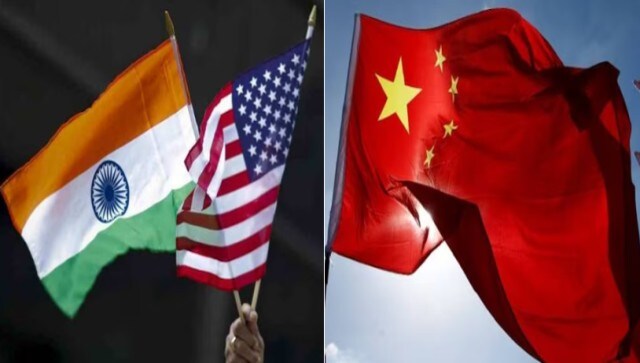Anushka Saxena

As India and China are engaged in continued dialogue on resolving the boundary issue, including through the recently conducted high-level meeting of the Working Mechanism for Consultation & Coordination on India-China Border Affairs, China faces a challenging theatre in its neighbourhood — the India-US alliance. Due to its threat perception of increasing proximity between India and the US, China inflates narratives of discord between the two countries, while also hyping up the nature of the challenge it faces, in order to arm-twist India into maintaining a more autonomous policy.
China’s geopolitical ambitions and strategies are dominated by competition with the US. This can be gauged from the conflicting responses of the two parties on critical tech supply chain resilience and self-reliance, the Russia-Ukraine war, or the larger hierarchy of power prevalent in the Indo-Pacific. Naturally, China is also wary of US interference in India’s China policy. For example, this wariness plays out in how China narrativises the US’ presence in the Indo-Pacific, and what role it sees for India in it.
The Chinese project India as a “key variable” in the US’ Indo-Pacific Strategy, and view India’s enhancing engagement with the Quad as an active effort to balance and contain it. Even recently, in November 2022, China criticised joint India-US military drills in Uttarakhand as “not conducive to the trust between India and China.”
At the same time, they express relief at India’s withdrawal from the trade pillar of the US-led Indo-Pacific Economic Framework. In India’s move, Chinese analysts find the implication that India and the US have an unresolvable dispute over the mechanism, which means that the “Western hype of ‘the US succeeded in winning over India’” is “nonsense.” Overall, in the endeavour to make more believable the threat of an India-US nexus, China inflates such narratives, and acts to coerce India into maintaining an autonomous policy.
At the same time, China severely downplays tensions along the Line of Actual Control (LAC) in an attempt to convince India that not only can the issue be resolved bilaterally, but it doesn’t also need to inch closer to the US or cooperate militarily. For example, in the conception of Wang Yi, China’s highest-ranking diplomat, “The boundary dispute, an issue left from history, is not the whole story of the China-India relationship,” and that “it should be kept in its own place and context.”
This differs starkly from India’s position on the matter, which External Affairs Minister S Jaishankar articulated as: “Our relationship is not normal, it cannot be normal as the border situation is not normal.”
Clearly, a dissonance in priorities has emerged, where India gives precedence to China and the LAC issue in its threat perception and security policy, while China sees India through the prism of its larger rivalry with the US. And even though China continues to remind India that the latter suffered a serious defeat at the hands of the People’s Liberation Army (PLA) in 1962, it also realises that any escalation of conflict into a war-like scenario both deflects Chinese resources away from its primary theatre of competition, and opens India up to the idea of aligning more closely with the US.
Not only is China’s India policy shaped by its larger rivalry with the US, there also exist genuine structural problems in India-China relations that aggravate discord. These emerge primarily from China’s attempts to keep India hemmed in the region. There is a stark difference in the kind of Asian regional order the two countries want — while India seeks a multipolar one, with India as one of the leading poles, China seeks a unipolar one, with India not being a pole at all.
China also seeks from India intangible commitments mentioned above, such as inching away from the US, especially on security and Indo-Pacific-related issues. But since India’s policy of strategic autonomy does not allow it to make hard commitments that distance it from either China or the US, the former refrains from giving India any of the concessions it seeks internationally, whether it be rapidly designating Masood Azhar or Abdul Makki as global terrorists in the UN Security Council, allowing for India’s membership in the Nuclear Suppliers Group, or enabling the resolution of the border issue even on the Line of Control, where China supports Pakistan at least with intelligence and equipment if not troops on the ground.
During the peak of tensions along the India-China border in June-July 2020, it was also reported that Pakistan stepped up deployment along the Line of Control (LoC) to match China’s troop strength on the LAC, indicating a planned China-Pakistan approach towards exacerbating India’s border insecurity.
In the larger picture, China believes that its nexus with Pakistan lies on one side of the emerging power balance in the Asia-Pacific, and on the other lies a US-led circle of partnerships with India, Australia, Japan, and others. And any further rapprochement between India and the US is a deterrence for the former’s eventual victory.
Therefore, we must continue to anticipate a greater emphasis within Chinese discourse and policy on India’s strategic autonomy from the US and the West, as well as prolonging the instability on the border to inhibit India’s regional partnerships and ambitions. At the same time, China could also see a potential opportunity if not a genuine desire to improve its relations with India to deter its full-fledged alliance with the US. As yet, neither have we seen any adjustments in China’s diplomatic approach to India, nor any disruptions in the India-US economic and defence partnerships.
The author is a Research Analyst with the Indo-Pacific Studies programme at Takshashila. She can be reached at anushka@takshashila.org.in.
No comments:
Post a Comment